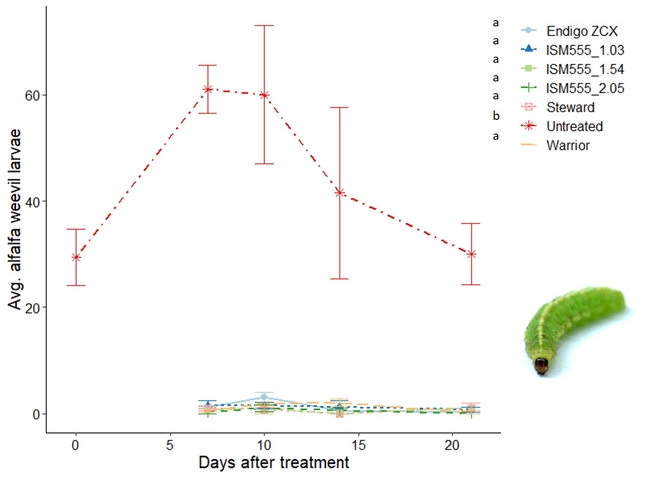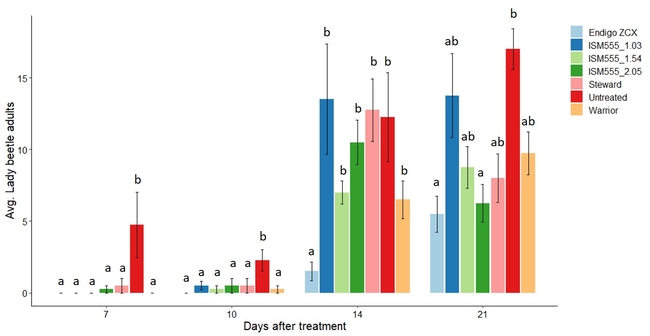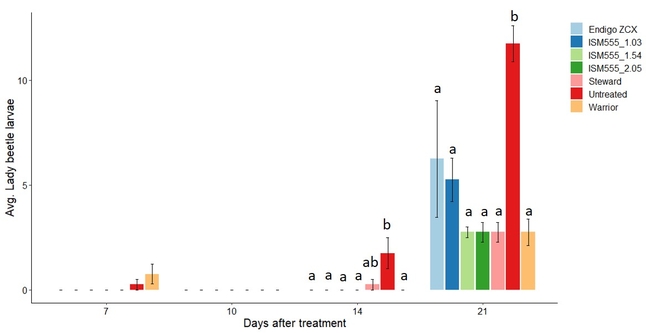During the 2021 season, we conducted an insecticide trial evaluating a new insecticide being developed for a range of crops. It could be a very good fit for alfalfa weevil given the efficacy we saw as well as the critical need for novel modes of action for alfalfa weevil management. The need for more modes of action comes from the growing issue with pyrethroid resistance in alfalfa weevils. Across the US (an in California), there are now populations of pyrethroid-resistant alfalfa weevils. We are addressing this in a separate project, focusing primarily on resistance to lambda-cyhalothrin. New modes of action could allow for rotation, something that is very difficult given that currently, effective options are mainly limited to various pyrethroids or indoxacarb (Steward).
The new material we were focused on was isocycloseram, marketed under the name of Plinazolin technology by Syngenta. This is a group 30 mode of action. Product names are not available yet given where it is at in the registration process and we were working with an experimental formulation at multiple rates. We also evaluated Endigo ZCX (lambda-cyhalothrin + thiamethoxam). These were compared to the current standards of Warrior II (lambda-cyhalothrin) and Steward (indoxacarb).
* Treatments 2-4 are with an experimental formulation, so the chemical name is listed here
This trial was conducted at the Intermountain Research and Extension Center in Tulelake, CA using 27 x 30 ft plots. The plots were managed using standard practices, although the field did not receive additional irrigation due to the water shortage in the Klamath Basin this last year. Applications were made once alfalfa weevil populations had built (I'd insert the average weevil count at 0 DAT here) using a CO2 powered backpack sprayer using a nine-foot handheld spray boom. Applications were made at 20 GPA and 30 PSI with TeeJet XR8002 nozzles. All treatments included Rainier-EA nonionic surfactant-activator-spreader at 0.25% v/v. Alfalfa was 18-in tall and pre-bud at application. Insects were sampled using 10 180° sweeps per plot. Pre-treatment samples were taken from just outside of the plot area (5 locations) to avoid disturbing the plots. Insect samples were taken 0, 7, 10, 14, and 21 DAT. No phytotoxicity was noted.
Alfalfa weevils
We found consistent effects of our treatments across evaluation dates and all insecticide treatments displayed similar efficacy. All treatments kept weevil populations below 2/10 sweeps, equating to at least 97% control for all insecticide treatments through 10 DAT. All treatments kept weevil populations low through 21 DAT as well. While pyrethroid resistance could be an issue in some regions, we did not expect to see that here and did not, with pyrethoid-containing materials working well. Weevil populations were increasing at the time of treatment and then began to decline 14 DAT through 21 DAT.
Effect of treatments on alfalfa weevil larvae populations. In the legend, treatments that do not share a letter are significantly different from one another analyzed across sampling dates (7-21 DAT).
Natural enemies
There were a few different natural enemies within our plots, so we also evaluated the effect of our treatments on these taxa to evaluate “non-target effects.” These included lady beetles, minute pirate bugs, and parasitoid wasps. Of note is that we have a limited suite of treatments, so we were not evaluating some of the other selective materials used in alfalfa like those that would tend to be used for aphids.
First, we have the lady beetles. These were primarily the seven-spotted lady beetle. Adult lady beetles were present at the beginning of the trial, while larvae were not. Adults lady beetles were decreased by all treatments relative to the control at 7 and 10 DAT. This is not unexpected given that all materials were effective against weevils, which is a beetle, just like lady beetles. There were still some lingering effects on adult lady beetles even through 21 DAT. Larvae were not present at the beginning of the trial, but once they showed up later, we saw effects of all of our insecticides on their populations relative to the untreated. It is likely the effects of adults at least partially explained what was happening with the larvae since the adults were not in some plots reproducing.
Effect of treatments on lady beetle adults. Treatments that do not share a letter are statistically different within a sampling date.
Effect of treatments on lady beetle larvae. Treatments that do not share a letter are statistically different within a sampling date.
Minute pirate bugs (Orius, data not presented) were affected by our treatments. Adult populations were highest in the untreated and Steward treatments at 7 and 10 DAT. Generally, the isocycloseram treatments were intermediate, with Endigo ZCX and Warrior having lower populations. Their clearly was some effect of this new material on minute pirate bugs, although the effect was not as extreme as pyrethroids, which we know are broad-spectrum insecticides.
We also counted parasitoid wasps in our samples, which could be parasitoids of aphids, caterpillars, or weevils. There was a consistent trend across dates, with the lowest numbers of wasps in the Warrior treatment, the highest number in the untreated, and all other treatments having intermediate numbers. This seems fairly similar to the minute pirate bug results, although with a bit less separation among treatments (isocycloseram treatments were statistically not different from either the untreated or the Warrior plots).
Overall, it appears isocycloseram has some negative effects on natural enemies but it does a better job conserving natural enemies than pyrethroids. Meanwhile, Steward minimally affects some natural enemies but clearly negatively affects others (lady beetles) which can be important natural enemies in alfalfa.
Conclusions
The results from this trial clearly indicate that isocycloseram is a novel mode of action that could have great potential for use managing alfalfa weevils. If registered in CA in alfalfa, this material could provide another option for weevils and another mode of action to use in rotation. This is especially critical given the severely limited number of effective options currently. Furthermore, in some areas, pyrethroids are ineffective due to insecticide resistance, placing an intense burden and selection pressure on the remaining materials, which is basically Steward in most cases. All other treatments worked very well on weevils, which is not unexpected.




